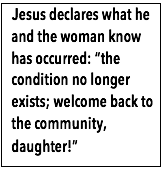Today’s
reading provides an excellent opportunity to reflect upon
health and healing in the ancient Mediterranean world. Modern
Western readers must suspend all that they know of the wonders
of contemporary scientific medicine in order to enter a world
where germs, microscopes, “cat scanners” and the impressive
array of modern drugs were unknown.
The Hemorrhaging Woman
This woman suffered from her problem of menstrual irregularity
for twelve years. Mark is often unfairly accused of physician
bashing for his comment that she “suffered much under
many physicians, spent all she had, and was no better but grew
worse” (Mk 5:26).
The ancient world knew at least two kinds of healers: professional
physicians and folk healers. Mark tells us that until the moment
she encountered Jesus, the hemorrhaging woman put all her trust
and resources in professional physicians. Perhaps she was of
elite status. Luke, who is very likely not a physician and
probably not the one mentioned by Paul in Colossians 4:14,
says the woman “could not be healed by anyone” (Lk 8:43).
 Professional physicians in antiquity have little if anything
in common with contemporary physicians. Because the Hebrews
considered God to be their chief healer (Ex 15:26) they developed
an ambivalent attitude toward professional physicians, as reflected
in Sirach 38:1-23. Professional physicians in antiquity have little if anything
in common with contemporary physicians. Because the Hebrews
considered God to be their chief healer (Ex 15:26) they developed
an ambivalent attitude toward professional physicians, as reflected
in Sirach 38:1-23.
Folk healers in antiquity were much more commonly available
to the peasants. They were willing to use their hands (Jn
9:6), touch people (Mk 8:22-26), and even risk failed treatments
(Mk 6:5-6). In the gospel reports, people definitely identified
Jesus as a folk healer, specifically a spiritfilled prophet
who could still storms, conquer malevolent spirits, and restore
people to their rightful and proper place in community.
In modern anthropological terms, we cannot know whether Jesus
cured anyone because curing is directed toward disease (germs,
viruses, and the like), and we have no evidence of the diseases
his petitioners may have been suffering. Moreover, even in
classical Greek literature, there is no indication that cures
were expected to be permanent.
But in the same terms, Jesus definitely healed all who wanted
to be healed. Healing is the restoration of meaning to people’s
lives no matter what their physical condition might be. Curing
is very rare, but healing takes place infallibly, 100 percent
of the time, because sooner or later all people regain meaning
in life and resume their rightful place in society.
This is certainly what Jesus accomplished for the hemorrhaging
woman. Her condition rendered her ritually unclean and not
only prevented her from entering the Temple but also required
that she remove herself from the community, the equivalent
of social death in the Mediterranean world.
Notice that Jesus sometimes is unaware of and has no control
over his power (Mk 5:39). The woman evoked it without his
awareness or permission. Nevertheless, Jesus declares what
he and the woman know has occurred: “the condition no
longer exists; welcome back to the community, daughter!”
The Dead Teenager
In the first century, 60 percent of live births usually died
by their mid-teens. The scene presented here was a very common
one.
Like other ancient healers, Jesus sometimes used a formula.
The fact that the Greek Gospel retains Jesus’ Aramaic words “Talitha koum” (“little girl, get up”) reflects the ancient
belief that power is in the original words and not the translation.
Some associate this with magic.
The crowd’s laughter at Jesus’ claim that the girl is only
sleeping challenges his honor. Jesus’ command that the family
say nothing is his way of getting even with the crowd. They’ll
never know what happened.
As proof that the girl is healed, that is, restored to her
rightful place in community, Jesus commands that she eat with
her family. Jesus the healer restores meaning to life and returns
people to communal solidarity.
John J. Pilch
|
John
J. Pilch is a biblical scholar and
facilitator of parish renewals.
Liturgical Press has published
fourteen books by Pilch exploring the
“cultural world” of the Bible.
Go to http://www.litpress.org/ to
find out more.
Copyright © 1997 by The Order of St.
Benedict, Inc., Collegeville, MN.
All rights reserved.
Used by permission from The
Liturgical Press, Collegeville,
Minnesota 56321
The complete text of the
above article can be found in:
The Cultural World of Jesus, Sunday by Sunday, Cycle B
John J. Pilch. The Liturgical Press. 1996. pp. 103-105.
Art by
Martin Erspamer, O.S.B.
from Religious Clip Art for the
Liturgical Year (A, B, and C).
Used by permission of Liturgy Training
Publications. This art may be reproduced
only by parishes who purchase the
collection in book or CD-ROM form. For
more information go to: http://www.ltp.org/
|
|